
|
|
|
|
|
|
2037-2039
EV market share is approaching 100% in most countries
By the late 2030s, the vast majority of new cars being purchased around the world are electric. This rapid shift to electric vehicles (EVs) has been driven by decades of technological innovation, policy changes, and shifting consumer preferences.
The rise of EVs began in earnest during the 2010s, a period marked by breakthroughs in battery technology, the expansion of charging infrastructure, and early government incentives aimed at reducing carbon emissions. The 2020s saw further acceleration as major automakers committed to phasing out internal combustion engine (ICE) vehicles, driven by stricter emissions regulations and a growing global awareness of climate change.
By 2030, Norway became the first country to achieve 100% electric car adoption, a precedent that many other nations would soon follow. The development of solid-state batteries, advancements in autonomous driving technology, and the proliferation of renewable energy sources were critical in making EVs not only a viable alternative but the preferred choice for consumers worldwide.
During the late 2030s, virtually all new cars being sold in developed nations – including the United States, Japan, and European countries – are electric, with only a small and rapidly diminishing fleet of older ICE cars remaining on the roads. This milestone has occurred faster than many analysts predicted. The International Energy Agency (IEA), for example, known for consistently underestimating the pace of solar and other clean technologies, anticipated a more linear progression* and failed to foresee exponential growth in the EV market.**
The rapid electrification of transport has led to a major decrease in global oil demand, with ripple effects on the economy and geopolitics. Oil-dependent nations, particularly those in the Middle East, have faced significant challenges as revenue from fossil fuels plummets. This has led to increased political instability in some of the more volatile regions, while others have accelerated their efforts to diversify their economies. Meanwhile, nations with robust renewable energy industries have gained geopolitical influence, becoming key exporters of the technologies and materials essential for the new energy landscape. The global energy transition has prompted major shifts in trade balances, investments, and alliances, reshaping the geopolitical map from just a decade earlier.
This trend extends into emerging economies during the 2040s.** Even regions like Africa will transition to electric cars by 2045, thanks to massive investments in infrastructure from China and elsewhere, combined with ongoing improvements in battery pricing, range, and charging times. While nearly all new car sales are dominated by electric vehicles, the market for older, second-hand ICE cars persists for a time. However, these traditional vehicles, increasingly unable to compete with the benefits of EVs, become obsolete shortly thereafter.
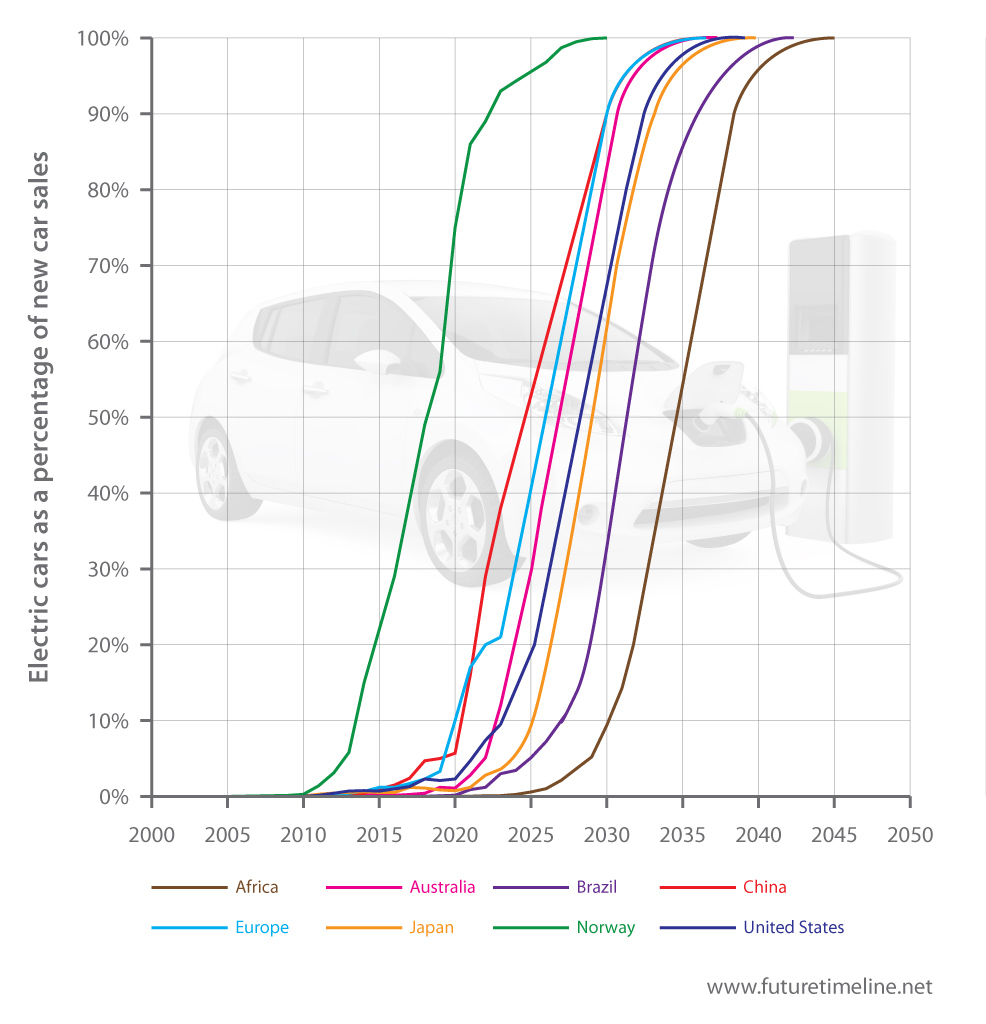
2037
Global population reaches 9 billion
For the vast majority of human history, the world's population stayed below 100 million. Life was often brutal and short. But the modern era led to unprecedented improvements in health, personal incomes, and general living standards. In just over a century, between 1805 and 1925, the number of humans on the planet doubled from one to two billion. It took only 35 years to reach the next billion and a mere 14 years to reach the billion after that. Population growth hit its maximum rate in 1963, peaking at 2.2% per annum.
These huge increases continued until the end of the 20th century and into the early 21st. Major environmental impacts now began to emerge as humanity exceeded planetary boundaries. The United Nations (UN) reported 15th November 2022 as the likely date when the global population reached 8 billion.*
The next milestone of 9 billion is reached in 2037.* This is sooner than a previous forecast by the UN, which had suggested 2042. It does, however, continue to indicate a slowing growth rate, since the 15 years after the last milestone is longer than the 12 years between the 7 and 8 billion milestones. The next milestone of 10 billion is predicted to be 21 years hence, in 2058.*
Countries growing at the fastest annual rate in 2037 include Niger (3.4%), the Democratic Republic of Congo (2.8%), and Mali (2.7%).* The most rapidly falling populations are the British overseas territory of Saint Helena (-1.2%), the U.S. territory of American Samoa (-1.1%), and Bulgaria (-1%). Larger and more prominent countries with declining populations include Ukraine (-0.7%), Japan (-0.7%), and Poland (-0.5%).
The density of humans on the planet has increased from 54/km² (2022) to 61/km² (2037), when measured by land surface area. More people than ever before are living in urban regions, up from 57% in 2022 to 63% in 2037.*
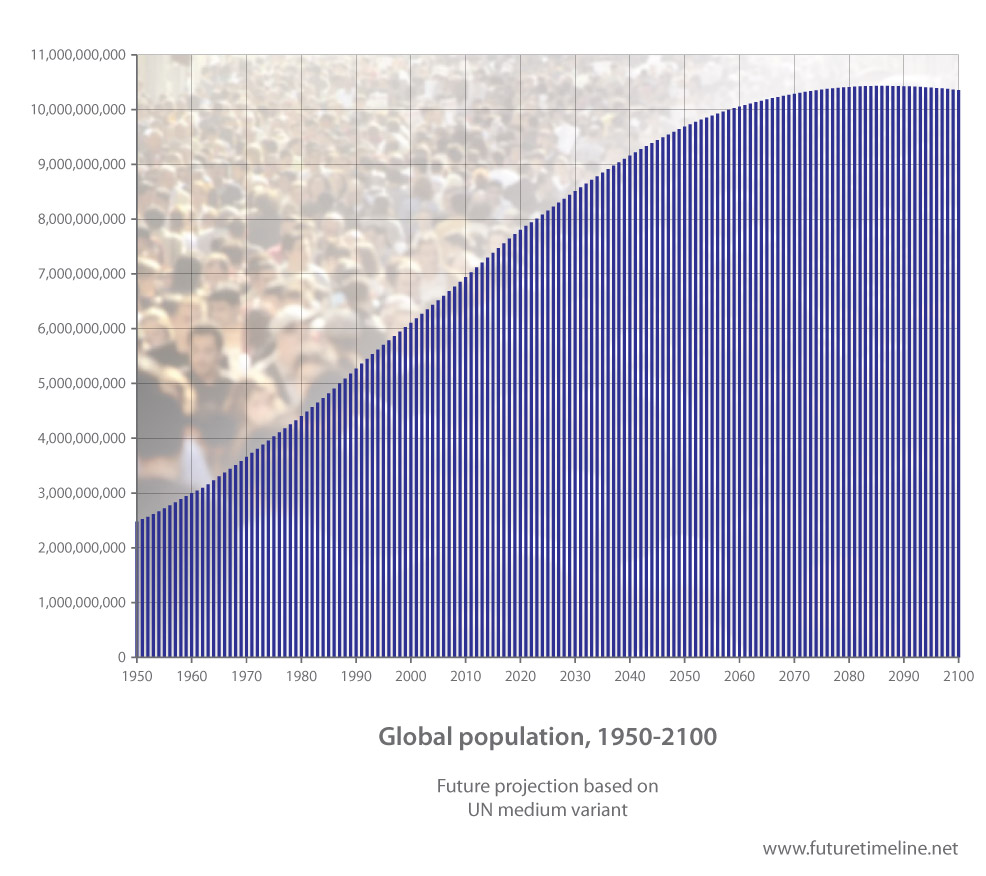
Global warming hits 1.5°C
A temporary breach of the 1.5°C limit agreed at the Paris Climate Accords had already been observed during a recent El Niño. This phenomenon is part of a natural heating cycle that occurs every four to seven years in the Pacific Ocean, resulting in particularly hot years. By 2037, the global average temperature is regularly exceeding this threshold,** with no sign of the increase slowing.
Panic is now setting in, as the impacts of climate change become ever more obvious – with increasingly frequent, record-breaking disasters throughout much of the world, accompanied by disrupted supply chains, falling crop yields, and surging numbers of displaced refugees. With its goal of 1.5°C now largely abandoned, the international community is focused on adaptation efforts and limiting the rise as much as possible.
By 2037, greenhouse gas emissions have recently peaked and are now declining. Most developed nations are in the final stages of a transition to renewable sources of electricity. The US, for example, has cut its overall emissions by 50% relative to 2005.* This is slower than required by the Paris Climate Agreement, but significantly more than had been expected by some earlier forecasts, due to a landmark bill passed in 2022. Meanwhile, the UK recently achieved a goal of producing 100% of its electricity without fossil fuels and, led by Prime Minister Keir Starmer, established a new publicly owned clean energy company known as Great British Energy.*
Even China – the world's largest emitter since 2006 – has now peaked its emissions and begun the long journey towards carbon neutrality, a goal it will reach within the next 30 years. India is close behind, on its way to net zero by 2070.
Significant advances have been made in cutting worldwide emissions of methane, a greenhouse gas with up to 96 times the warming potential of carbon dioxide when measured on a per-molecule basis over a 20-year timescale. At the COP26 summit in 2021, more than 100 nations agreed a 30% reduction in methane emissions by 2030. While this pledge fell short of its original target, enough progress occurred to achieve a peak and decline, which has continued with another seven years of reductions.
Despite these recent developments, greenhouse gas emissions remain dangerously high, with climate impacts accelerating. Just a decade and a half remains until the middle of the century and a potential breach of the 2°C threshold.
By 2037, the annual chance of a European summer like the 2003 heatwave has reached 30-50%. Warm spell durations in Northern Europe and the Mediterranean have increased by 14 and 15 days, respectively. Annual water availability in the Mediterranean has declined by 9%, while the area burned by summer wildfires has increased by more than 40%.*
In the Americas, temperature increases already exceed the 1.5°C global average – ranging from 1.8°C in the south and southwestern United States to as high as 2.4°C in the northeastern states.* As a result, US crops are being negatively affected, with maize yields now typically at least 10% below where they should be. Other impacts include the Mississippi River now experiencing an 18% increase in the frequency of extreme high flows. The length of the tropical rain season has declined by three days in Central America and as much as ten days in northern Brazil. In Amazonia, warm spell durations have increased by 28 days and the frequency of warm extremes over land has soared by more than 250%.
In Africa, the picture is more mixed. For example, while some regions have seen little or no change in rainfall, others such as the Greater Horn of Africa are experiencing as much as 17% more rainfall. The frequency of extreme high river flows has increased by 9% in the Nile and 25% in the Congo.* The number of people exposed to water scarcity has remained stable in the Sahara region, declined by 13 million in West Africa, and increased by five to six million in the eastern and southern parts of the continent.
In Asia, glacier masses in high mountains are on average 36% lower.* This has been accompanied by an increase in landslides, erosion, and floods, now a common feature in news reports, due to their devastating impact on populated areas below. By mid-century, glacier volumes in the Everest region will have declined by half (relative to 2015),* with serious consequences for water availability. The frequency of warm extremes over land has increased substantially throughout much of the continent – from 76% in Northern Asia to as much as 235% in Western Asia. However, the Russian Federation has benefited from a decrease of one month in average drought length. In terms of populations exposed to river flooding, the worst increases are being experienced by the countries of India (326%), Bhutan (261%), and Bangladesh (227%). For China, the figure is 93%. Despite increasingly disruptive climate events, Asia's crop yields have remained relatively stable, for now, although this will change with 2°C of global warming.
By the late 2030s, the Arctic Ocean is becoming almost entirely ice-free during some months.* The resulting change of albedo – from reflective white to a darker and more heat-absorbing surface – is creating feedback loops of amplified warming. The jet stream is also being altered, changing the movement of weather patterns over North America, Europe, and Russia. In a somewhat counterintuitive trend, cold winter extremes in some parts of the northern hemisphere are becoming more likely and winter storms are being driven further south. This is caused by the increasing moisture capacity of the atmosphere, with about 7% more water vapour carried per 1°C of temperature rise. The shifting jet stream is also influencing the path of hurricanes and worsening their damage.
In addition to these immediate short-term impacts, the breaching of 1.5°C has set in motion a number of longer-term trends.* This includes the almost total loss of the Great Barrier Reef by 2050, and a vast thawing of boreal permafrost. The loss of both the Greenland and West Antarctic ice sheets (together accounting for a combined 9 metres of sea level rise in the coming centuries) is no longer a mere possibility, but now likely.*
A growing sense of doom pervades the world, as nations scramble to protect their own interests amid the deteriorating geopolitical situation. Wars are being fought over water, land, and other resources. Borders are becoming tighter. Financial markets are volatile, as fossil fuel demand undergoes a series of collapses. Tourism is declining in many regions, due to environmental impacts. Mental health is also suffering, with depression the number one global disease burden.* People are becoming reluctant to have children, or even to work and forge careers, as they foresee a bleak future. The sheer uncertainty is a defining feature of this time. The level of political and economic uncertainty in the world had been increasing since the financial crash of 2008 and this trend has continued.*
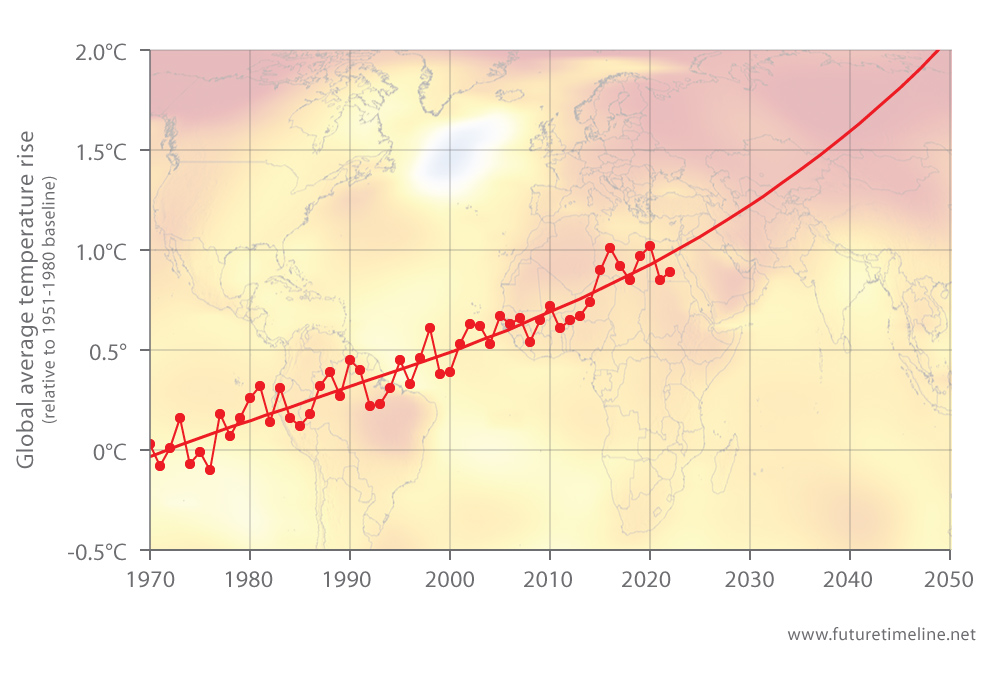
Launch of the European Athena X-ray observatory
The Advanced Telescope for High-ENergy Astrophysics (Athena) is a major new X-ray telescope launched by the European Space Agency (ESA). This L-class (Large) mission is part of the Cosmic Vision programme which includes two other spacecraft – the Jupiter Icy Moon Explorer (JUICE) and the Laser Interferometer Space Antenna (LISA).
X-ray observations are crucial for understanding the structure and evolution of stars, galaxies, and the Universe as a whole. These images can reveal "hot spots" – regions where particles have been energised or raised to very high temperatures by strong magnetic fields, violent explosions, and intense gravitational forces. X-ray sources are also associated with the different phases of stellar evolution such as supernova remnants, neutron stars, and black holes.
Athena is designed to answer some of the most fundamental questions in astrophysics. It studies what happens close to black holes and how these objects grow and influence their host galaxies, observing hundreds of thousands of them across cosmic time – from those relatively nearby to others that formed in the first few hundred million years after the Big Bang. It studies how ordinary matter assembles into the vast structures of the Universe – from galaxies and clusters to the filaments of the cosmic web – and how these processes connect with one another. By observing the faint X-rays that trace hot gas across space, Athena also searches for the Universe's "missing" matter and reveals how energy from black holes shapes their surroundings. In addition, the observatory responds to sudden cosmic events, such as powerful bursts or collisions detected through gravitational waves, providing a fuller picture of how the energetic Universe evolves.
To perform its studies, Athena carries two main instruments, onto which X-rays are focused by a single large mirror. The Wide Field Imager (WFI) maps vast regions of the sky, while the X-ray Integral Field Unit (X-IFU) captures the faint "fingerprints" of superheated gas swirling around black holes and galaxy clusters. The mirror's collecting area of 1.4 m² (15 ft²) is the largest ever achieved for an X-ray telescope and nearly 20 times greater than NASA's Chandra. This order of magnitude leap in detail opens a new window on the hot and energetic Universe. These devices can also respond rapidly to cosmic outbursts, including sources linked to gravitational-wave events, allowing scientists to capture fleeting high-energy phenomena that would otherwise vanish before they can be studied.
Athena's story began in 2014, when ESA selected it for the Cosmic Vision 2015–2025 programme. During the early 2020s, the project faced rising costs and scheduling pressures, prompting ESA to pause work and initiate a major redesign known as "NewAthena". Engineers restructured the mission to make it leaner and more reliable while keeping its most ambitious goals intact. This involved simplifying the cooling system for the ultra-cold X-ray camera, revising parts of the spacecraft to reduce complexity, and refining the wide-field imaging system. These adjustments trimmed some of the original performance targets but kept the mission scientifically transformative and technically achievable. Originally planned for a 2028 launch, it instead takes flight in 2037.
From this year onward, Athena operates at Sun–Earth Lagrange Point 1 in a large halo orbit, maintaining a 1.5 million kilometre distance from Earth. The mission is designed for a five-year nominal lifetime, with possible extensions during the 2040s.*
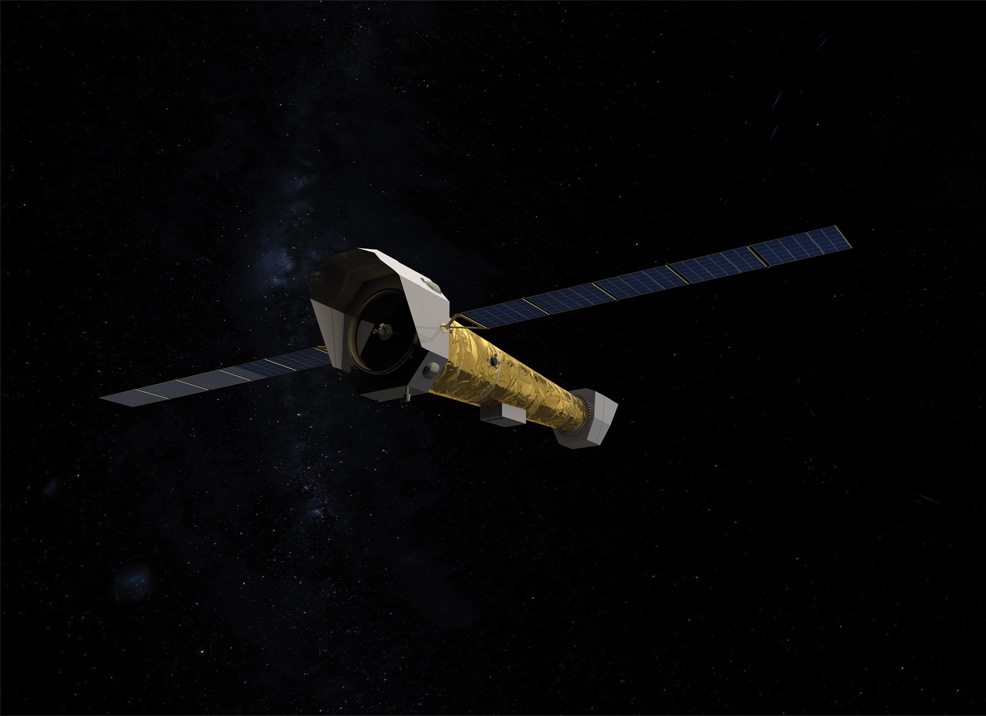
Credit: ESA/IRAP/CNRS/UT3/CNES/Fab&Fab
Total solar eclipse in Australia and New Zealand
A total solar eclipse occurs on 13th July 2037.* It passes through the centre of Australia at 2:40 UTC (12:40 local time) with maximum eclipse occurring near the intersection of three states – Queensland, the Northern Territory and South Australia – before moving across the North Island of New Zealand. Totality has a duration of three minutes and 58 seconds.*
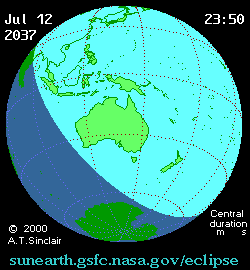
America's sixth-generation fighter jet enters service
By 2037, deliveries of the F-35 Lightning II for the U.S. military have ceased.* Although the aircraft is scheduled to remain in service until 2070,* it is succeeded around this time by a sixth generation of planes that begins to be rolled out. The U.S. Navy's existing fleet of F/A-18 Super Hornets is also being retired now, necessitating a replacement. The new fighter jets are procured for both the U.S. Navy (a program known as F/A-XX) and Air Force (known as F-X). In terms of technology they are a major leap over the F-35 and also designed to outclass China's Chengdu J-20 and Shenyang J-31.
The sixth-generation jets feature increased autonomy (with the option of being unmanned), orders of magnitude improvements in computer processing and algorithmic power, faster manoeuvring and sensing of the battlespace, hypersonic weapons, laser guns, advanced electronic warfare capabilities, better stealth technology and so-called "smart skins" where sensors are built into the side of the aircraft itself to reduce drag.* They incorporate a supersonic tailless design for the first time ever, made possible through advanced computer modelling and new materials.*
The Oxford English Dictionary 3rd edition is published
Work on the original version of The Oxford English Dictionary began in 1857, when a small group of intellectuals in London (unconnected to Oxford University) became dissatisfied with the existing English dictionaries. They formed an "Unregistered Words Committee" to search for words unlisted or poorly defined in current dictionaries. The gradual realisation of the project's immense scale – far greater than any previous effort – led to the idea of a new, truly comprehensive dictionary organised in a series of volumes.
It took until 1888 for the first of these to be published, covering words beginning with the letters A and B. Another 40 years would pass before the final entries in the V to Z range, marking the 10th and final volume, completed in 1928.
As the English language evolved through the 20th century, the first edition became outdated. The need to accommodate many new words and phrases resulted in additional supplements and, eventually, a complete second edition. Published in 1989, this took advantage of recent advances in computerisation to improve the editing and production process. The second edition increased the number of word definitions from 400,000 to 600,000 and the number of volumes from 10 to 20. Author Anthony Burgess declared it "the greatest publishing event of the century", while TIME magazine dubbed the book "a scholarly Everest" and The Guardian called it "one of the wonders of the world".
Following the launch of an online version in 2000, the dictionary's editors began a major revision project to create a completely new third edition, at a projected cost of £34 million. Apart from general updates to include information on new words and other changes in the English language, the third edition brings many other improvements – including changes in formatting and stylistic conventions for easier reading and computerised searching, more etymological information, and a general change of focus away from individual words towards more general coverage of the language as a whole. While the original text drew its quotations mainly from literary sources such as novels, plays, and poetry, with additional material from newspapers and academic journals, the new edition references more kinds of material that were unavailable to editors of earlier editions, such as wills, inventories, account books, diaries, journals, letters, blogs, and Twitter posts. This third edition, roughly double the overall length of the second,* is finally completed in 2037.*

Seven of the 20 volumes of the printed 2nd edition of The Oxford English Dictionary (1989)
Credit: Dan (mrpolyonymous on Flickr), CC BY 2.0, via Wikimedia Commons
« 2036 |
⇡ Back to top ⇡ |
2038 » |
If you enjoy our content, please consider sharing it:
References
1 Global EV Outlook 2024, IEA:
https://www.iea.org/reports/global-ev-outlook-2024
For archived version, see:
https://www.futuretimeline.net/21stcentury/pdfs/iea-global-ev-outlook-2024.pdf
Accessed 18th August 2024.
2 Electric vehicles to pass two thirds of global car sales by 2030, University of Exeter:
https://news.exeter.ac.uk/faculty-of-environment-science-and-economy/electric-vehicles-to-pass-two-thirds-of-global-car-sales-by-2030/
Accessed 18th August 2024.
3 X-Change: Cars, RMI:
https://rmi.org/insight/x-change-cars/
For archived version, see:
https://www.futuretimeline.net/21stcentury/pdfs/x-change-cars-report.pdf
Accessed 18th August 2024.
4 The electric vehicle revolution in Sub-Saharan Africa: Trends, challenges, and opportunities, Science Direct:
https://www.sciencedirect.com/science/article/pii/S2211467X24000919
Accessed 18th August 2024.
5 Financing the transition to electric vehicles in sub-Saharan Africa, Shell Foundation:
https://shellfoundation.org/app/uploads/2022/02/EV-Report-McKinsey.pdf
For archived version, see:
https://www.futuretimeline.net/21stcentury/pdfs/ev-report-mckinsey.pdf
Accessed 18th August 2024.
6 Global population reaches 8 billion, Future Timeline Blog:
https://www.futuretimeline.net/blog/2022/11/15-global-population-future-timeline.htm
Accessed 20th November 2022.
7 Day of 8 Billion, UN:
https://www.un.org/en/dayof8billion
Accessed 20th November 2022.
8 2022 Revision of World Population Prospects, United Nations:
https://population.un.org/wpp/
Accessed 20th November 2022.
9 Population & Demography Data Explorer, Our World In Data:
https://ourworldindata.org/explorers/population-and-demography
Accessed 20th November 2022.
10 Urban population, 1950-2100, Future Timeline Data & Trends:
https://www.futuretimeline.net/data-trends/12.htm
Accessed 20th November 2022.
11 "...take the rate of historical warming over the past 30 years and extend it into the future. In that case, we would expect global temperatures to exceed 1.5C around 2037."
Analysis: When might the world exceed 1.5C and 2C of global warming?, Carbon Brief:
https://www.carbonbrief.org/analysis-when-might-the-world-exceed-1-5c-and-2c-of-global-warming/
Accessed 23rd April 2023.
12 Extrapolated from NASA's GISTEMP temperature series:
See GISS Surface Temperature Analysis (v4), Carbon Brief:
https://data.giss.nasa.gov/gistemp/graphs_v4/
Accessed 23rd April 2023.
13 Climate bill could slash US emissions by 40% after historic Senate vote, The Guardian:
https://www.theguardian.com/environment/2022/aug/05/us-climate-bill-slash-emissions-analysis-biden
Accessed 21st October 2022.
14 Labour is right: it's time for Britain to profit from its own renewables, The Guardian:
https://www.theguardian.com/commentisfree/2022/sep/28/labour-public-ownership-affordable-energy-net-zero-britain
Accessed 21st October 2022.
15 The impacts of climate change at 1.5C, 2C and beyond, Carbon Brief:
https://interactive.carbonbrief.org/impacts-climate-change-one-point-five-degrees-two-degrees/
Accessed 21st October 2022.
16 The impacts of climate change at 1.5C, 2C and beyond, Carbon Brief:
https://interactive.carbonbrief.org/impacts-climate-change-one-point-five-degrees-two-degrees/
Accessed 21st October 2022.
17 The impacts of climate change at 1.5C, 2C and beyond, Carbon Brief:
https://interactive.carbonbrief.org/impacts-climate-change-one-point-five-degrees-two-degrees/
Accessed 21st October 2022.
18 The impacts of climate change at 1.5C, 2C and beyond, Carbon Brief:
https://interactive.carbonbrief.org/impacts-climate-change-one-point-five-degrees-two-degrees/
Accessed 21st October 2022.
19 See 2048-2058.
20 Observation-based selection of climate models projects Arctic ice-free summers around 2035, Nature:
https://www.nature.com/articles/s43247-021-00214-7
Accessed 21st October 2022.
21 World on brink of five 'disastrous' climate tipping points, study finds, The Guardian:
https://www.theguardian.com/environment/2022/sep/08/world-on-brink-five-climate-tipping-points-study-finds
Accessed 21st October 2022.
22 Risk of multiple climate tipping points escalates above 1.5°C global warming, EurekAlert!:
https://www.eurekalert.org/news-releases/963785
Accessed 21st October 2022.
23 See 2030.
24 Economic Policy Uncertainty Index, Economic Policy Uncertainty:
https://www.policyuncertainty.com/
Accessed 21st October 2022.
25 NewAthena factsheet, European Space Agency:
https://www.esa.int/Science_Exploration/Space_Science/NewAthena_factsheet
Accessed 5th November 2025.
26 13 July 2037 — Total Solar Eclipse, Time and Date:
https://www.timeanddate.com/eclipse/solar/2037-july-13
Accessed 2nd February 2017.
27 Solar eclipse of July 13, 2037, Wikipedia:
https://en.wikipedia.org/wiki/Solar_eclipse_of_July_13,_2037
Accessed 2nd February 2017.
28 Lockheed Martin F-35 Lightning II, Wikipedia:
https://en.wikipedia.org/wiki/Lockheed_Martin_F-35_Lightning_II
Accessed 15th February 2017.
29 Lockheed F-35 service life extended to 2070, Flight Global:
https://www.flightglobal.com/news/articles/lockheed-f-35-service-life-extended-to-2070-423536/
Accessed 15th February 2017.
30 Why America's 6th-Generation Fighter (What Comes After the F-35) Could Be a Game Changer, The National Interest:
http://nationalinterest.org/blog/the-buzz/why-americas-6th-generation-fighter-what-comes-after-the-f-18066
Accessed 15th February 2017.
31 Northrop Developing 6th Gen Fighter Plans, Defense News:
http://www.defensenews.com/story/defense/air-space/strike/2015/01/21/northrop-6th-gen-fighter/22089857/
Accessed 15th February 2017.
32 The evolving role of the Oxford English Dictionary, Financial Times:
https://www.ft.com/content/dfdfba02-4c70-11e3-958f-00144feabdc0
Accessed 27th October 2022.
33 Deadline 2037: the making of the next Oxford English Dictionary, The Irish Times:
https://www.irishtimes.com/culture/deadline-2037-the-making-of-the-next-oxford-english-dictionary-1.1667328
Accessed 27th October 2022.
![[+]](https://www.futuretimeline.net/images/buttons/expand-symbol.gif)






